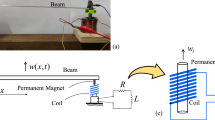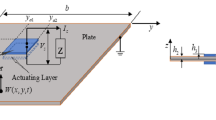Abstract
The need for control or suppression of vibrations in mechanical structures has arisen because of their damaging effects on people, civil structures and machine parts. The present work aims to perform the vibration control of a portico type structure with two degrees of freedom, using piezoelectric transducers associated with negative capacitance shunt circuits with series electrical resistance. For this purpose, an electronic circuit with passive and active components associated with piezoelectric transducers QP10W was developed to produce a negative capacitance shunt circuit, implemented through Negative Impedance Converters (NIC) and using operational amplifiers. The response amplitudes of the system in the time domain and the frequency in free and forced vibration were analyzed in tests performed with and without shunt circuit operation in the system. Considering free vibration, a reduction of 9.01 dB was obtained for the first natural frequency and of 6.95 dB for the second one. For forced vibration, reductions of 1.5 dB were obtained for the first natural frequency and 2.19 dB for the second natural frequency, respectively. The vibration reductions obtained with the proposed system demonstrate the efficiency of the system.












Similar content being viewed by others
Availability of data and material
Data are part of an ongoing study and cannot be shared at this moment.
References
Cheng FY, Jiang H, Lou K (2008) Smart structures: innovative systems for seismic response control, 1st ed. Taylor & Francis Group
Dorf RC, Bishop RH (2001) Sistemas de Controle Modernos, eigth ed., LTC Publishing
Yan B, Wang K, Hu Z, Wu C, Zhang X (2017) Shunt damping vibration control technology: a review. Appl Sci 7(794):1–31. https://doi.org/10.3390/app7050494
Moheimani SOR, Fleming AJ (2006) Piezoelectric transducers for vibration control and damping. Springer
Behrens S, Fleming AJ, Moheimani SOR (2001) New method for multiple-mode shunt damping of structural vibration using a single piezoelectric transducer. In: Proceedings of SPIE 4331, smart structures and materials: damping and IsolationSmart structures and materials, pp 239–250. https://doi.org/10.1117/12.432707
Behrens S, Fleming AJ, Moheimani SOR (2003) A broadband controller for shunt piezoelectric damping of structural vibration. Smart Mater. Struct 12:18–28 http://stacks.iop.org/0964-1726/12/i=1/a=303
Marneffe B, Preumont A (2008) Vibration damping with negative capacitance shunts: theory and experiment. Smart Mater Struct 17:035015. https://doi.org/10.1088/0964-1726/17/3/035015
Beck BS, Cunefare KA, Collet M, Ruzzene M (2011) Active vibration control of a stiffened panel through application of negative capacitance shunts. In: Proceedings of SPIE 7977, active and passive smart structures and integrated systems 79770C. https://doi.org/10.1117/12.880418
Tateo F, Collet M, Ouisse M, Ichchou MN, Cunefare KA, Abbe A (2014) Experimental characterization of a bi-dimensional array of negative capacitance piezo-patches for vibroacoustic control. J Intell Mater Syst Struct 26(8):952–964. https://doi.org/10.1177/1045389X14536006
Heuss O, Salloum R, Mayer D, Melz T (2014) Tuning of a vibration absorber with shunted piezoelectric transducers. Arch Appl Mech 86:1715–1732. https://doi.org/10.1007/s00419-014-0972-5
Beck BS, Cunefare KA, Collet M (2014) Response-based tuning of a negative capacitance shunt for vibration control. J Intell Mater Syst Struct 25(13):1585–1595. https://doi.org/10.1177/1045389X13510216
Wahid A, Muthalif AA, Nor KAM (2016) Investigating negative capacitance shunt circuit for broadband vibration damping and utilizing ACO for optimization. Int J Circuits Electron 1:168–173. ISSN: 2367-8879
Honda T, Jikuya I, Takagi K (2018) A parameter tuning method of negative capacitor circuit for piezoelectric shunt damping. Active Passive Smart Struct Integr Syst XII 10595(1059533):1–8. https://doi.org/10.1117/12.2295891
Berardengo M, Manzoni S, Thomas O, Giraud-Audine C (2015) A new electrical circuit with negative capacitances to enhance resistive shunt damping. In: Proceedings of the ASME 2015 conference on smart materials, adaptive structure and intelligent systems (2015), 1–9. http://proceedings.asmedigitalcollection.asme.org/
Berardengo M, Thomas O, Giraud-Audine C, Manzoni S (2016) Improved resistive shunt by means of negative capacitance: new circuit, performances and multi-mode control. Smart Mater Struct 25:075033 http://hdl.handle.net/10985/11320
Berardengo M, Thomas O, Giraud-Audine C, Manzoni S (2017) Improved shunt damping with two negative capacitances: an efficient alternative to resonant shunt. J Intell Mater Syst Struct 28(16):2222–2238. https://doi.org/10.1177/1045389X16667556
Gripp JAB, Heuss O, Góes LCS, Melz T (2014) Adaptive resonant piezoelectric shunt damping enhanced by a synthetic negative capacitance. Proceedings of ISMA2014 Including USD2014, pp 653–666
Yan B, Wang K, Hu Z, Wu C, Zhang X (2017) Shunt damping vibration control technology: a review. Appl Sci 7(494):1–31. https://doi.org/10.3390/app7050494
Gonçalves APS (2016) Active control of vibrations in a 2 DOF frame using piezoelectric transducers associated with negative capacitance shunt circuits, masters dissertation, Federal University of Campina Grande, Campina Grande, 2016
PI CERAMICS. Catalogue of Piezoelectric Actuators and Sensors. http://www.piceramic.com
Park CH, Park HC (2003) Multiple-mode structural vibration control using negative capacitive shunt damping. KSME Int J 17(11):1650–1658. https://doi.org/10.1007/BF02983594
Santana DC (2007) Numerical modeling and optimization of piezoelectric shunts applied to passive vibration control, doctoral thesis, Federal University of Uberlandia, Uberlandia
Venet MZ, Pereira AHA (2004) Materiais e Dispositivos Piezoelétricos: Fundamentos e Desenvolvimento. Apostila - Curso de Piezoeletrico da ATCP do Brasil, São Carlos-SP
Institute of Electrical and Electronics Engineers Inc. IEEE Standard on Piezoelectricity. ANSI/IEEE Std. 176–1987, 1988
Viana FAC (2005) Amortecimento de Vibrações Usando Pastilhas Piezeletricas e Circuitos Shunt Ressonantes, Master thesis. Universidade Federal de Uberlandia, Uberlandia
Hagood NW, Von Flotow A (1991) Damping of structural vibrations with piezoelectric materials and passive electrical networks. J Sound Vibr 146:243–268. https://doi.org/10.1016/0022-460X(91)90762-9
QUICKPACK PIEZO PRODUCTS. Material Properties & Spec Sheets. Midé Technology Corporation
ST MICROELECTRONICS. Datasheet LM 324, 2001. http://pdf.datasheetcatalog.com/datasheets/150/61350_DS.pdf
Beck BS (2012) Negative capacitance shunting of piezoelectric patches for vibration control of continuous systems, master thesis, Georgia Institute of Technology, Georgia,
Behrens S (2000) Passive and semi-active vibration control of piezoelectric laminates, master thesis, University of Newcastle, Australia
Funding
The authors acknowledge the financial support and the award fellowship provided by the Vibration and Instrumentation Laboratory of Federal University of Campina Grande (LVI/UFCG), National Council for Scientific and Technological Development (CNPq), Grants 306732/2012-2 and 444039/2014-7. This study was financed in part by the Coordenação de Aperfeiçoamento de Pessoal de Nível Superior - Brasil (CAPES) - Finance Code 001.
Author information
Authors and Affiliations
Corresponding author
Ethics declarations
Conflicts of interest
Nothing to declare.
Code availability
Not applicable.
Rights and permissions
About this article
Cite this article
Gonçalves, A., Almeida, A., Moura, E.d. et al. Active vibration control in a two degrees of freedom structure using piezoelectric transducers associated with negative capacitance shunt circuits. Int. J. Dynam. Control 9, 71–84 (2021). https://doi.org/10.1007/s40435-020-00652-9
Received:
Revised:
Accepted:
Published:
Issue Date:
DOI: https://doi.org/10.1007/s40435-020-00652-9




